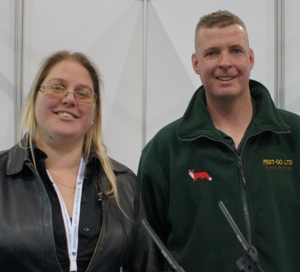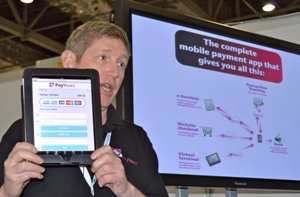|
Launched in 1995, it now has 200 members and represents a total of 100 actives. These comprise ‘microbials’ including bacteria and viruses, ‘macrobials’ covering parastic insects and worms, ‘Semiochemicals’ such as pheromones and plant volatiles and ‘natural products’.
Originally targeting agriculture, members of the IBMA are now extending their scope to other markets including pest control.
Incidents waiting to happen in fumigation
Introduced by David Heaton, chairman of the Fumigation and Controlled Environments Forum (FACE), Richard Moseley outlined developments on ‘Ship Cargo/Container Fumigation: Risk Reduction Strategies’, the importance of this subject being underscored by last December’s incident in Northern Ireland.
Richard observed that there were some 17 million containers in international use. Even if just 1% of these were fumigated and incorrectly labelled, there would be some 170,000 potential incidents waiting to happen annually!
Richard described the correct procedures for fumigating, labelling, handling and venting containers to assure safety.
Bats – not easy to locate
In the session on ‘Bats and Buildings’, Kelly Gunnell from the Bat Conservation Trust reminded pest controllers of the importance of recognising the signs that indicate that bats use a site. Spotting an actual bat is often very difficult as all 18 species found in the UK are very small and most hideaway in crevices making them extremely difficult to spot. The task is made all the harder because bats use different sites at different times of year so they may not be present at the time you are looking for them.
However, all sites used by bats continue to be protected whether or not the bats are actually in residence at the time. She also pointed out that using a bat detector which detects echolocation is of no use in a building used as a roost as the bats only echolocate when they are out hunting for insects. She emphasised that the Bat Conservation Trust is not an enforcement body but a charity which offers free advice so if in doubt she recommended that pest controllers give them a call.
Foxes – best practice
‘Urban Foxes’ also attracted a good crowd. Louise Summers and Steve Barron were representing a fledgling new organisation – the Association for Urban Wildlife Professionals – which is to be officially launched this July. They provided plenty of food for thought on best management practice. In particular they pointed out that any large scale culling of urban foxes was hugely sensitive and frankly very unlikely to succeed. Urban foxes need to be managed not controlled.
The first actions should be to look to exclude or deter the animals, they said. Only those individuals which are behaving abnormally, probably because they have had too much contact with humans as cubs and learned not to be frighten of people, need to be removed and that in Steve’s view means caught and shot and definitely not relocated to the country. He pointed out that not only is relocating stressful to the individual fox concerned it will more than likely lead to the death of the fox as other foxes already established in the territory will attack it. Relocating foxes is also likely to spread disease particularly mange which is rife in many urban fox populations.
A smart payment system
Not all of the seminars were of a technical nature; there was a number of business oriented sessions too. One, entitled ‘Business Payment Systems’, was of particular interest to small pest control service businesses. It was presented by Matthew Sanderson of ‘PayYours’.
His company has produced a smartphone application via which the technician could complete credit and debit card transactions. Not only did this reduce ‘debtor days’, it carried a lower percentage fee for processing credit card transactions than is available to most small businesses, and a low flat rate payment for debit card transactions. The monthly ‘app’ fee was also realistic and attractive for small businesses.
More men than women!
Marketing was the subject of a seminar sponsored by Professional Women in Pest Management (PWIPM) and it attracted four times as many men as it did women! The session was led by Killgerm’s marketing director, Sabra Fearon. Char Taylor from Xenex Associates who attended explains: “We were told that ‘a brand is a promise wrapped up in an experience’. It’s about how you represent yourself, how customers and potential customers perceive you – about making a good impression. We learnt how to make a lasting impression and how your website is the new shop window for your business.The point was also made that marketing does not have to cost money. Simple tools such as social media, PR and word of mouth are all great ways of promoting your business.
“There was a discussion on how to differentiate ourselves if we were setting up a new pest control business and a presentation on how to identify your market, understand the customer’s needs and produce a simple marketing plan. To conclude everyone was asked to write down five marketing actions they would like to implement in the next three months. These lists were then put into envelopes, sealed, addressed to ourselves and handed in. The envelopes will be posted out in three months time so that we could see if we had successfully implemented what we had written down.”
|

Biocontrol options were
discussed by David Cary

Chairman of FACE,
David Heaton introduced
the fumigation session

Kelly Gunnell of the
Bat Conservation Trust
 Manage not control urban foxes say Louise Summers and Steve Barron Manage not control urban foxes say Louise Summers and Steve Barron

Smart payments methods outlined by
Matthew Sanderson from PayYours

Sabra Fearon outlines how
companies can cost-effectively
differentiate themselves
|






 Manage not control urban foxes say Louise Summers and Steve Barron
Manage not control urban foxes say Louise Summers and Steve Barron